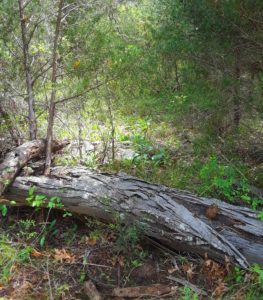Finding And Completing A Cedar Circle
When my brother moved to Vashon Island, WA, he became friends with a couple who studied Native American traditions. One thing they did on their property was plant a group of cedars in a circle, creating a sacred space cedar circle. I’ve tried to respectfully learn more about this tradition, but haven’t found much.
This much I do know: As the cedars grew, their branches innerlocked. They seemed to embrace each other. Carefully moving the branches aside brought my brother and I into the cedar circle: A quiet, sacred space, where the outside world seemed far away. The only things present (besides my brother and I) was the ground, the cedars, and — looking up — the sky. We held a couple of good discussions in that sacred space, and gained a lot of clarity. My brother also said that he had spent many hours there, pondering, reading, studying, praying.
Shortly after I purchased my property, I noticed that — unlike much of the land nearby — the hill seems to be covered with red cedars. My brother suggested I do what he was doing on his land: Plant a cedar circle. Fortunately for both of us, cedar trees are native to both western Washington and Northwest Georgia.
I decided I would take his advice and transplant red cedars to create a cedar circle, that type of sacred space. I knew that it would be several years before the cedars would be large enough to shut out the outside world, but I reasoned “Better start now, rather than regret it later.”
As I was walking through my property looking for small trees to dig up and transplant, I noticed something ususual. In one area in particular, the trees had, of their own accord, formed a small circle. It felt right to be in that space. In fact, I think I will put a chair there and use it for my personal, small space.
Unfortunately, I quickly recognized that, while the space is perfect NOW, in about 3-4 years the trees will have grown so much that there will be no space inside of the cedar circle. Already, there is no space for more than one person. Clearly, I needed to find — or create — a larger cedar circle.
Reasoning that, if there was one, there would probably be more, I began walking across the property. It was an interesting exercize: Instead of looking for cedar trees as individuals, I began to look at them and how they related to other cedars nearby. Did they stand alone? Or were there groups together? What shape did they form? Most importantly, how did I feel when I was in the midst of the trees? Welcomed? Or like I was intruding? In harmony? Or like I was creating some sort of dischord?

Then, suddenly, there it was. I moved aside — and eventually trimmed away — several invasive, non-native privet bushes, because they were crowding into the native cedar trees. Stepping through the gap they’d created, I suddenly was in a large, yet comfortable, cedar circle that felt like sacred space. A large limestone slab was inside the circle. A fallen hickory tree was across the northern edge of the circle, but everything in that space seemed to say “Here. Come. Be.”
Today I went back into the cedar circle, and realized that, once I’d cleared away the privet bushes, there were two gaps that exposed the circle to the outside. Walking nearby, I found two small cedars, about 2 feet high. I reasoned that I could dig them up, move them to fill in the gaps, and within a few years, they will be part of that cedar circle, part of that sacred space.

As if to verify my logic, the soil in the gaps was surprisingly lush, deep, and not at all rocky (unlike most of the rest of the property). I quickly dug two large holes. Digging up the small cedars and transplanting them proved to be very easy as well.
I have no doubt that the two transplants will soon join branches with the others, blocking out sight and sound, allowing those who obtain that sacred space to have the spiritual connection with themselves and with nature that they are seeking. Whether people are thinking, meditating, praying, resting, healing, connecting with nature or with each other, sharing or conversing; whether standing or sitting on the limestone slab, the native grasses, or the hickory trunk, I believe that cedar circle was created awhile ago to become sacred space focused for us to carefully, quietly and reverently use.
As I stood in that sacred space, I felt prompted to offer a single word I’ve often heard a Tlingit friend of mine say: Gunalchéesh! I’m certain the Cherokee who were on this land also often said: Wado!
As the breeze moved through the cedar boughs, I could hear the trees answer: “You’re welcome!” and knew it meant more than just a courtesy response.